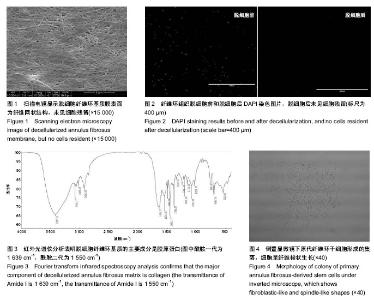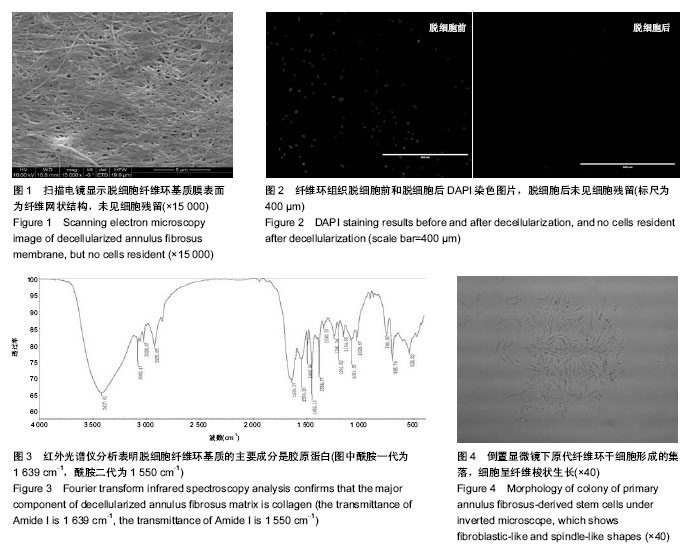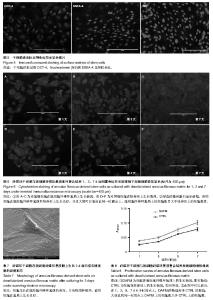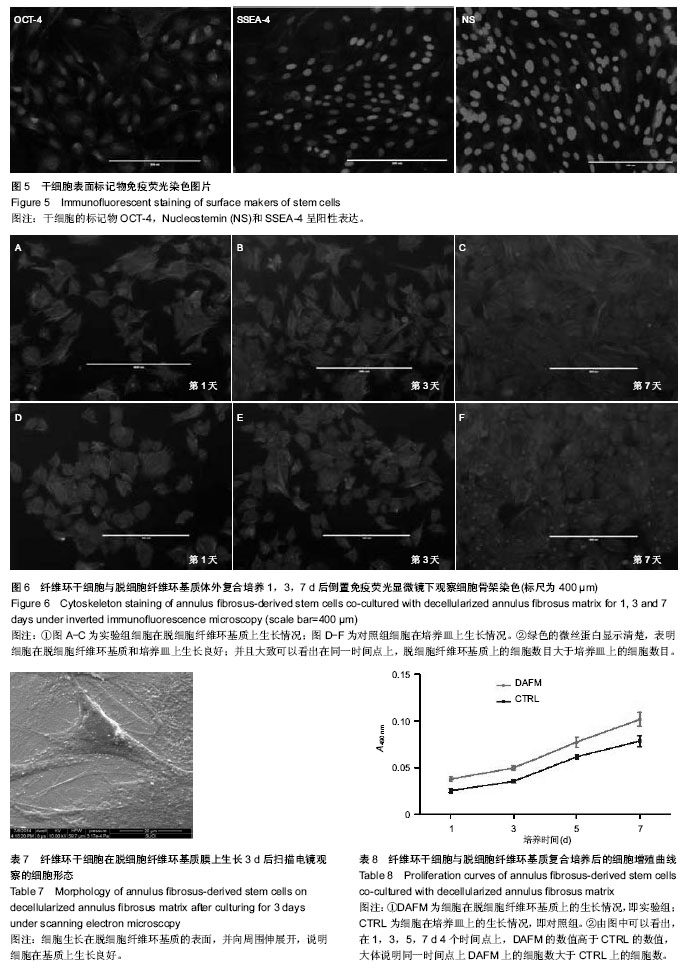| [1] Alini M, Roughley PJ, Antoniou J,et al.A biological approach to treating disc degeneration: not for today, but maybe for tomorrow.Eur Spine J. 2002;11 Suppl 2:S215-220.
[2] Gertzbein SD, Hollopeter MR. Disc herniation after lumbar fusion. Spine (Phila Pa 1976). 2002;27(16):E373-376.
[3] Wilda H, Gough JE.In vitro studies of annulus fibrosus disc cell attachment, differentiation and matrix production on PDLLA/45S5 Bioglass composite films.Biomaterials. 2006; 27(30):5220-5229.
[4] Nerurkar NL, Sen S, Huang AH,et al.Engineered disc-like angle-ply structures for intervertebral disc replacement.Spine (Phila Pa 1976). 2010;35(8):867-873.
[5] Alini M, Li W, Markovic P,et al.The potential and limitations of a cell-seeded collagen/hyaluronan scaffold to engineer an intervertebral disc-like matrix.Spine (Phila Pa 1976). 2003; 28(5):446-454.
[6] Hegewald AA, Ringe J, Sittinger M,et al.Regenerative treatment strategies in spinal surgery.Front Biosci. 2008;13: 1507-1525.
[7] Sebastine IM, Williams DJ.Current developments in tissue engineering of nucleus pulposus for the treatment of intervertebral disc degeneration.Conf Proc IEEE Eng Med Biol Soc. 2007;2007:6401-6406.
[8] Wilke HJ, Heuer F, Neidlinger-Wilke C,et al.Is a collagen scaffold for a tissue engineered nucleus replacement capable of restoring disc height and stability in an animal model?Eur Spine J. 2006;15 Suppl 3:S433-438.
[9] Zhang J, Li B, Wang JH.The role of engineered tendon matrix in the stemness of tendon stem cells in vitro and the promotion of tendon-like tissue formation in vivo.Biomaterials. 2011;32(29):6972-6981.
[10] Valentin JE, Turner NJ, Gilbert TW, et al.Functional skeletal muscle formation with a biologic scaffold.Biomaterials. 2010; 31(29):7475-7484.
[11] Reing JE, Zhang L, Myers-Irvin J,et al.Degradation products of extracellular matrix affect cell migration and proliferation.Tissue Eng Part A. 2009;15(3):605-614.
[12] Seif-Naraghi SB, Singelyn JM, Salvatore MA,et al.Safety and efficacy of an injectable extracellular matrix hydrogel for treating myocardial infarction.Sci Transl Med. 2013;5(173): 173ra25.
[13] Singelyn JM, DeQuach JA, Seif-Naraghi SB,et al.Naturally derived myocardial matrix as an injectable scaffold for cardiac tissue engineering.Biomaterials. 2009;30(29):5409-5416.
[14] Koepsell L, Zhang L, Neufeld D,et al.Electrospun nanofibrous polycaprolactone scaffolds for tissue engineering of annulus fibrosus.Macromol Biosci. 2011;11(3):391-399.
[15] Nerurkar NL, Elliott DM, Mauck RL.Mechanics of oriented electrospun nanofibrous scaffolds for annulus fibrosus tissue engineering.J Orthop Res. 2007;25(8):1018-1028.
[16] Vadalà G, Mozetic P, Rainer A,et al.Bioactive electrospun scaffold for annulus fibrosus repair and regeneration.Eur Spine J. 2012;21 Suppl 1:S20-26.
[17] Chou AI, Bansal A, Miller GJ,et al.The effect of serial monolayer passaging on the collagen expression profile of outer and inner anulus fibrosus cells.Spine (Phila Pa 1976). 2006;31(17):1875-1881.
[18] Kluba T, Niemeyer T, Gaissmaier C,et al.Human anulus fibrosis and nucleus pulposus cells of the intervertebral disc: effect of degeneration and culture system on cell phenotype. Spine (Phila Pa 1976). 2005;30(24):2743-2748.
[19] Risbud MV, Guttapalli A, Tsai TT,et al.Evidence for skeletal progenitor cells in the degenerate human intervertebral disc.Spine (Phila Pa 1976). 2007;32(23):2537-2544.
[20] Yoshimura H, Muneta T, Nimura A, et al.Comparison of rat mesenchymal stem cells derived from bone marrow, synovium, periosteum, adipose tissue, and muscle.Cell Tissue Res. 2007;327(3):449-462.
[21] Liu C, Guo Q, Li J, et al. Indentification of rabbit annulus fibrosus-derived stem cells. PLos One. 2014; 9: e108239.
[22] Attia M, Santerre JP, Kandel RA.The response of annulus fibrosus cell to fibronectin-coated nanofibrous polyurethane- anionic dihydroxyoligomer scaffolds. Biomaterials. 2011;32(2): 450-460.
[23] Turner KG, Ahmed N, Santerre JP,et al.Modulation of annulus fibrosus cell alignment and function on oriented nanofibrous polyurethane scaffolds under tension.Spine J. 2014;14(3): 424-434.
[24] Yeganegi M, Kandel RA, Santerre JP.Characterization of a biodegradable electrospun polyurethane nanofiber scaffold: Mechanical properties and cytotoxicity.Acta Biomater. 2010; 6(10):3847-3855.
[25] Gruber HE, Fisher EC Jr, Desai B, et al.Human intervertebral disc cells from the annulus: three-dimensional culture in agarose or alginate and responsiveness to TGF-beta1.Exp Cell Res. 1997;235(1):13-21.
[26] Di Martino A, Sittinger M, Risbud MV.Chitosan: a versatile biopolymer for orthopaedic tissue-engineering.Biomaterials. 2005;26(30):5983-5990.
[27] Chan LK, Leung VY, Tam V,et al.Decellularized bovine intervertebral disc as a natural scaffold for xenogenic cell studies.Acta Biomater. 2013;9(2):5262-5272.
[28] Böer U, Lohrenz A, Klingenberg M,et al.The effect of detergent-based decellularization procedures on cellular proteins and immunogenicity in equine carotid artery grafts. Biomaterials. 2011;32(36):9730-9737.
[29] Cheng HL, Loai Y, Beaumont M,et al.The acellular matrix (ACM) for bladder tissue engineering: A quantitative magnetic resonance imaging study.Magn Reson Med. 2010;64(2): 341-348.
[30] Dong SW, Ying DJ, Duan XJ,et al.Bone regeneration using an acellular extracellular matrix and bone marrow mesenchymal stem cells expressing Cbfa1.Biosci Biotechnol Biochem. 2009; 73(10):2226-33.
[31] Kheir E, Stapleton T, Shaw D,et al.Development and characterization of an acellular porcine cartilage bone matrix for use in tissue engineering.J Biomed Mater Res A. 2011; 99(2): 283-294.
[32] Stapleton TW, Ingram J, Fisher J,et al.Investigation of the regenerative capacity of an acellular porcine medial meniscus for tissue engineering applications.Tissue Eng Part A. 2011; 17(1-2):231-242.
[33] Zhao Y, Zhang Z, Wang J,et al.Abdominal hernia repair with a decellularized dermal scaffold seeded with autologous bone marrow-derived mesenchymal stem cells.Artif Organs. 2012; 36(3):247-255. |



